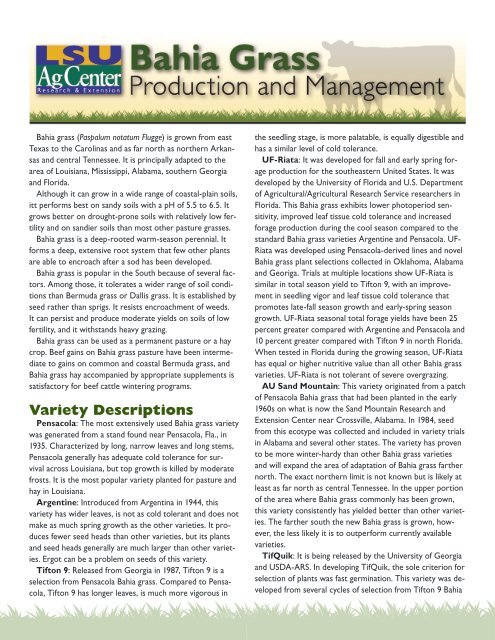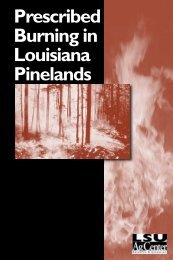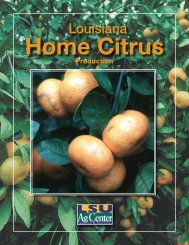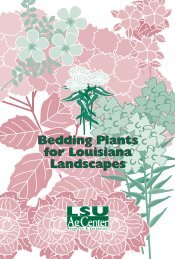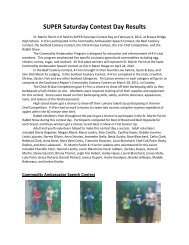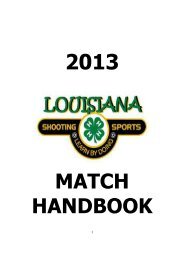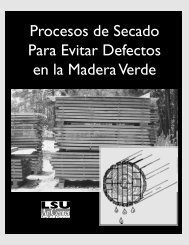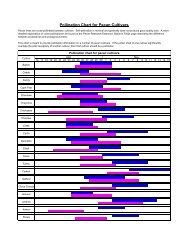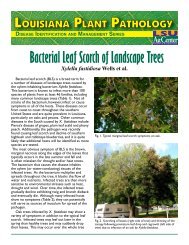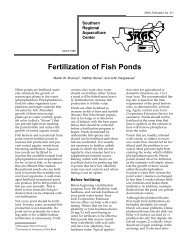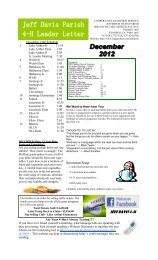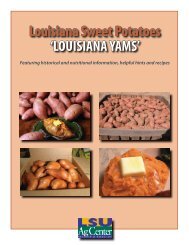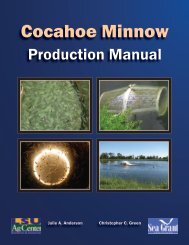Variety Descriptions - The LSU AgCenter
Variety Descriptions - The LSU AgCenter
Variety Descriptions - The LSU AgCenter
Create successful ePaper yourself
Turn your PDF publications into a flip-book with our unique Google optimized e-Paper software.
Bahia grass (Paspalum notatum Flugge) is grown from east<br />
Texas to the Carolinas and as far north as northern Arkansas<br />
and central Tennessee. It is principally adapted to the<br />
area of Louisiana, Mississippi, Alabama, southern Georgia<br />
and Florida.<br />
Although it can grow in a wide range of coastal-plain soils,<br />
itt performs best on sandy soils with a pH of 5.5 to 6.5. It<br />
grows better on drought-prone soils with relatively low fertility<br />
and on sandier soils than most other pasture grasses.<br />
Bahia grass is a deep-rooted warm-season perennial. It<br />
forms a deep, extensive root system that few other plants<br />
are able to encroach after a sod has been developed.<br />
Bahia grass is popular in the South because of several factors.<br />
Among those, it tolerates a wider range of soil conditions<br />
than Bermuda grass or Dallis grass. It is established by<br />
seed rather than sprigs. It resists encroachment of weeds.<br />
It can persist and produce moderate yields on soils of low<br />
fertility, and it withstands heavy grazing.<br />
Bahia grass can be used as a permanent pasture or a hay<br />
crop. Beef gains on Bahia grass pasture have been intermediate<br />
to gains on common and coastal Bermuda grass, and<br />
Bahia grass hay accompanied by appropriate supplements is<br />
satisfactory for beef cattle wintering programs.<br />
<strong>Variety</strong> <strong>Descriptions</strong><br />
Pensacola: <strong>The</strong> most extensively used Bahia grass variety<br />
was generated from a stand found near Pensacola, Fla., in<br />
1935. Characterized by long, narrow leaves and long stems,<br />
Pensacola generally has adequate cold tolerance for survival<br />
across Louisiana, but top growth is killed by moderate<br />
frosts. It is the most popular variety planted for pasture and<br />
hay in Louisiana.<br />
Argentine: Introduced from Argentina in 1944, this<br />
variety has wider leaves, is not as cold tolerant and does not<br />
make as much spring growth as the other varieties. It produces<br />
fewer seed heads than other varieties, but its plants<br />
and seed heads generally are much larger than other varieties.<br />
Ergot can be a problem on seeds of this variety.<br />
Tifton 9: Released from Georgia in 1987, Tifton 9 is a<br />
selection from Pensacola Bahia grass. Compared to Pensacola,<br />
Tifton 9 has longer leaves, is much more vigorous in<br />
the seedling stage, is more palatable, is equally digestible and<br />
has a similar level of cold tolerance.<br />
UF-Riata: It was developed for fall and early spring forage<br />
production for the southeastern United States. It was<br />
developed by the University of Florida and U.S. Department<br />
of Agricultural/Agricultural Research Service researchers in<br />
Florida. This Bahia grass exhibits lower photoperiod sensitivity,<br />
improved leaf tissue cold tolerance and increased<br />
forage production during the cool season compared to the<br />
standard Bahia grass varieties Argentine and Pensacola. UF-<br />
Riata was developed using Pensacola-derived lines and novel<br />
Bahia grass plant selections collected in Oklahoma, Alabama<br />
and Georiga. Trials at multiple locations show UF-Riata is<br />
similar in total season yield to Tifton 9, with an improvement<br />
in seedling vigor and leaf tissue cold tolerance that<br />
promotes late-fall season growth and early-spring season<br />
growth. UF-Riata seasonal total forage yields have been 25<br />
percent greater compared with Argentine and Pensacola and<br />
10 percent greater compared with Tifton 9 in north Florida.<br />
When tested in Florida during the growing season, UF-Riata<br />
has equal or higher nutritive value than all other Bahia grass<br />
varieties. UF-Riata is not tolerant of severe overgrazing.<br />
AU Sand Mountain: This variety originated from a patch<br />
of Pensacola Bahia grass that had been planted in the early<br />
1960s on what is now the Sand Mountain Research and<br />
Extension Center near Crossville, Alabama. In 1984, seed<br />
from this ecotype was collected and included in variety trials<br />
in Alabama and several other states. <strong>The</strong> variety has proven<br />
to be more winter-hardy than other Bahia grass varieties<br />
and will expand the area of adaptation of Bahia grass farther<br />
north. <strong>The</strong> exact northern limit is not known but is likely at<br />
least as far north as central Tennessee. In the upper portion<br />
of the area where Bahia grass commonly has been grown,<br />
this variety consistently has yielded better than other varieties.<br />
<strong>The</strong> farther south the new Bahia grass is grown, however,<br />
the less likely it is to outperform currently available<br />
varieties.<br />
TifQuik: It is being released by the University of Georgia<br />
and USDA-ARS. In developing TifQuik, the sole criterion for<br />
selection of plants was fast germination. This variety was developed<br />
from several cycles of selection from Tifton 9 Bahia
grass. In greenhouse studies, germination of TifQuik averaged<br />
five times more that Tifton 9 after six days and three<br />
times more after eight days. In the field studies, TifQuik<br />
emerged about 75 percent faster after one week than Tifton<br />
9 and Pensacola varieties. After four weeks, TifQuik plants<br />
were taller than both Tifton 9 and Pensacola. Dry-matter<br />
yields of TifQuik were two times higher than Tifton 9 and<br />
four times higher than Pensacola for the first clipping, which<br />
was done two months after planting. <strong>The</strong> main advantage of<br />
TifQuik over other available varieties is its rapid germination<br />
and higher initial forage production.<br />
Establishment<br />
Plant Bahia grass between March 1 and June 1 at a seeding<br />
rate of 15 pounds of pure live seed per acre. (<strong>The</strong> superior<br />
seedling vigor of the variety Tifton 9 allows successful stand<br />
establishment from substantially lower seeding rates when<br />
environmental conditions are favorable, however.)<br />
Bahia grass also can be planted in the summer and fall,<br />
but these seedings usually are riskier than spring seedings.<br />
One problem with summer seedings is that the soil dries<br />
out quickly and germinating seedlings may die. Also, in north<br />
Louisiana, the risk of winterkill is a serious threat to stands<br />
that are seeded late.<br />
Bahia grass should be planted on a well-prepared seedbed<br />
at a depth of about ½ inch. Use a cultipacker or roller after<br />
seeding to firm the soil, conserve moisture and speed germination.<br />
Successful stands can be obtained from broadcasting<br />
the seed in mixture with the planting fertilizer application,<br />
but seed viability can be reduced if the mixture is stored<br />
before spreading.<br />
Apply fertilizer according to soil test recommendations.<br />
Apply only 20 to 40 pounds of nitrogen per acre at planting.<br />
Applying higher rates will encourage excessive weed competition.<br />
After the planted grass emerges and begins to cover,<br />
apply 40 to 60 pounds of nitrogen per acre. Small seedlings<br />
of Bahia grass are weak competitors with weeds. For fast<br />
establishment of a productive Bahia grass stand, weeds must<br />
be controlled.<br />
Mow frequently during the months following seeding. This<br />
prevents other grasses and weeds from forming a canopy<br />
over the young Bahia grass seedlings. <strong>The</strong> herbicide 2, 4-D<br />
can be used to control many broadleaf weeds in Bahia grass,<br />
but don’t apply it to Bahia grass less than 4 or 5 inches tall<br />
because it will damage or kill small Bahia grass seedlings.<br />
<strong>The</strong>re are no selective herbicides that will take grassy weeds<br />
out of a Bahia grass stand. Frequent mowing is the only solution<br />
to eliminating these weeds.<br />
Grazing should not be practiced for about three months<br />
after planting or until the stand is thick enough that the<br />
ground cannot be seen.<br />
Be patient when attempting to establish Bahia grass. It<br />
contains a moderate to large percentage of dormant seed<br />
that germinate over a period of months. Toward the end of<br />
the summer, some plants may be fully grown and others only<br />
several inches tall. It is difficult to evaluate a stand of Bahia<br />
grass before the end of the summer of the establishment<br />
year. Even if a stand contains only one plant per square foot,<br />
it probably should be kept because the Bahia grass may outcompete<br />
the weeds during the spring of the next year.<br />
<strong>Variety</strong> Performance<br />
and Quality<br />
Research comparing varieties has led to variable results. In<br />
experiments at the <strong>LSU</strong> <strong>AgCenter</strong>’s Rosepine Research Station,<br />
Argentine produced more forage than Pensacola in one<br />
year, and Tifton 9 produced more forage than Argentine or<br />
Pensacola in another year (Table 1).<br />
Research at the <strong>LSU</strong> <strong>AgCenter</strong>’s Southeast Research Station<br />
has shown few differences in yield among Pensacola,<br />
Tifton 9 or Argentine when compared at three harvest frequencies,<br />
but Tifton 9 and Pensacola were more productive<br />
at the first harvest than Argentine. This slow spring growth<br />
for Argentine also has been reported in Florida research.<br />
Differences in forage quality among varieties also appear to<br />
be fairly small (Table 2). Since these three Bahia grass varieties<br />
have been shown to be similar in productivity and quality,<br />
producers should base variety selection on seed availability<br />
and cost.<br />
Table 1. Dry forage yields of three Bahia grass varieties<br />
for two different planting years at the <strong>LSU</strong> <strong>AgCenter</strong>’s<br />
Rosepine Research Station<br />
<strong>Variety</strong> 1990 planting 1991 planting<br />
tons/acre<br />
Argentine 5.7 a 5.3 b<br />
Pensacola 5.1 b 5.3 b<br />
Tifton 9 5.3 ab 6.0 a<br />
Values within a column followed by a different letter are significantly<br />
different (P
Fertility Management<br />
Bahia grass has a somewhat undeserved reputation for not<br />
responding to nitrogen fertilization and rarely receives high<br />
nitrogen fertilizer rates. Research at the <strong>LSU</strong> <strong>AgCenter</strong>’s<br />
Southeast Research Station has demonstrated Bahia grass is<br />
very responsive to nitrogen fertilization (Table 3).<br />
Table 3. Dry matter, yield, crude protein (CP) and yield<br />
of CP per acre of Pensacola Bahia grass at four nitrogen<br />
fertility levels<br />
Nitrogen Yield CP CP/acre<br />
lb./acre tons/acre % lb./acre<br />
0 1.8 10.5 370<br />
200 5.3 12.6 1350<br />
300 6.4 13.6 1740<br />
400 7.0 14.4 2010<br />
Bahia grass stands produce a dense sod with large storage<br />
reserves of energy which can support regrowth following<br />
abusive grazing, severe drought or other disturbances. This<br />
dense sod allows Bahia grass to take up large amounts of<br />
nitrogen, even from a single fertilizer application, and store<br />
this nutrient for later use. Growth responses to a single<br />
application of 200 pounds of nitrogen per acre (600 pounds<br />
of ammonium nitrate per acre) were obtained through two<br />
years after application in a Florida grazing trial.<br />
When growing conditions are favorable, Bahia grass typically<br />
produces a sudden burst of growth in response to nitrogen<br />
fertilization. This rapid growth actually can contribute<br />
to subsequent low-quality forage because rapid late spring<br />
and early summer forage often is only partially used when<br />
grazed at typical stocking rates. Patches are grazed and then<br />
grazed again as long as regrowth is rapid. When the growth<br />
rate decreases, the pasture is a mosaic of excessively grazed<br />
spots and tall, rank, unpalatable, poor-quality areas. This<br />
aspect of Bahia grass use is the greatest challenge in effective<br />
use of nitrogen fertilizer on Bahia grass pastures.<br />
While intensive rotational grazing may enhance management<br />
of Bahia grass pastures during periods of rapid growth,<br />
another approach is to apply nitrogen only at times and in<br />
amounts that will meet forage needs. Some accumulated late<br />
summer and autumn growth can be used effectively for winter<br />
forage when appropriately supplemented. Accumulated<br />
spring and early summer growth is detrimental, however, to<br />
both subsequent production of regrowth and quality of available<br />
forage from midsummer through autumn.<br />
If Bahia grass is to be used as a pasture, apply all of the<br />
phosphate and potash recommended by soil analysis and 60<br />
to 80 pounds of nitrogen in the spring soon after the grass<br />
begins to grow. An additional 60 to 80 pounds of nitrogen<br />
should be applied in early to mid-June. In South Louisiana,<br />
another 30 to 40 pounds of nitrogen may be applied in late<br />
August or early September for late fall grazing if ryegrass is<br />
not going to be overseeded in the field.<br />
If Bahia grass is to be used as a hay crop and cut three<br />
to four times a year, apply 300 to 400 pounds of nitrogen<br />
per acre per year. If only one or two cuttings are planned,<br />
about 200 pounds of nitrogen per acre per year should be<br />
adequate. Use these rates in split applications with no more<br />
than 100 pounds of nitrogen applied at any one time.<br />
Forage Quality<br />
Bahia grass has a reputation as a low-quality forage. <strong>The</strong><br />
quality of Bahia grass hay tends to be lower than the quality<br />
of Bermuda grass or mixed warm-season grass hay (Table 4).<br />
When the quality of Bahia grass is adequate for making<br />
good quality hay, the grass seems too short to cut. Once it<br />
seems tall enough to cut for hay, forage quality is low, and<br />
there are many seed heads. Often during July, August and<br />
early September the quality is low even on relatively young<br />
growth. For optimum production of high-quality Bahia grass<br />
hay, take the first cutting at the boot to early heading stage<br />
and then cut every 30 to 35 days if growth permits.<br />
Table 4. Average forage quality of warm-season hay<br />
samples sent to the <strong>LSU</strong> <strong>AgCenter</strong>’s Southeast Research<br />
Station Forage Quality Laboratory in 1992<br />
Hay type<br />
Crude<br />
Protein<br />
Total<br />
Digestible<br />
Nutrients<br />
Acid<br />
Detergent<br />
Fiber<br />
%<br />
Bahia grass 8.3 50.0 44.2<br />
Bermuda grass 10.7 54.4 40.4<br />
Mixed grass 9.3 50.7 43.1<br />
Grazing Management<br />
Since Bahia grass has predominantly low-growing, dense<br />
growth, it is an excellent grass for use in grazing. About 40<br />
percent of Bahia grass forage is produced between 0 and 1<br />
inch in height. Bahia grass must be closely grazed or clipped<br />
to keep it tender and succulent with good quality. When Bahia<br />
grass has grown 8 to 10 inches tall, it is very tough, low<br />
quality and unpalatable. It produces very little new growth<br />
after it reaches this stage, and the quality drops the longer it<br />
stands. Research conducted in Georgia found the digestibility<br />
of Bahia grass declined from 68 percent in mid-May to 45<br />
percent by late August.<br />
Results from grazing trials have varied. Florida research<br />
demonstrated cattle grazing Bahia grass do not gain more<br />
than about 1 pound per day over the entire grazing season.<br />
Animal performance was higher in the spring, but from July<br />
through September cattle gained very little or even lost
weight. In contrast, Georgia research reported cattle gained<br />
more than 1.5 pounds per day grazing Pensacola Bahia grass.<br />
When comparing performance of cattle grazing Bahia grass<br />
to that of Bermuda grass, however, most studies have demonstrated<br />
higher animal gains on Bermuda grass (Table 5).<br />
As a rule, it is a good management practice to clip Bahia<br />
grass pastures periodically to remove seed heads and keep<br />
the plants in a vegetative and palatable growth stage. Stocking<br />
rates on Bahia grass pasture during the growing season should<br />
be in the range of about one cow per 1.5 to 2 acres.<br />
Table 5. Average daily gain and beef production per<br />
acre for steers grazing three grass varieties during four<br />
years at Tifton, Ga.<br />
<strong>Variety</strong><br />
Average<br />
Daily Gain<br />
Beef<br />
Production<br />
lbs. lbs./acre<br />
Pensacola Bahia grass 0.95 222<br />
Coastal Bermuda grass 1.08 331<br />
Coastcross-1 Bermuda grass 1.50 469<br />
Overseeding<br />
Since Bahia grass forms a dense, tough sod, it is sometimes<br />
difficult to obtain adequate stands of winter annual grasses<br />
such as ryegrass when they are overseeded into an established<br />
stand of Bahia grass during the fall.<br />
Before overseeding, clip or graze the Bahia grass as close<br />
to the ground as possible. Harrowing or light-disking the<br />
area after seeding is recommended to get the seed in contact<br />
with the soil and speed germination.<br />
Results with overseeding of legumes into Bahia grass sod<br />
have varied. Crimson clover and white clover are probably<br />
the best choices to overseed into an established stand of<br />
Bahia grass.<br />
Invasive Nature<br />
of Bahia grass<br />
In contrast to the typical slow establishment of new plantings<br />
of Bahia grass, this grass can be an aggressive invader of<br />
other species.<br />
Rotating cattle from Bahia grass pastures to those of other<br />
species such as Bermuda grass can bring in Bahia grass seed<br />
the cattle have consumed. <strong>The</strong>se seed can establish small<br />
patches of Bahia grass that spread aggressively and can dominate<br />
the pasture after a few years.<br />
Since most Bahia grass hay contains mature seed, feeding<br />
such hay on Bermuda grass pastures often results in the<br />
introduction or spreading of Bahia grass. This invasive nature<br />
limits the use of Bahia grass where a management objective<br />
is to maintain pure stands of other grass species, especially<br />
hybrid Bermuda grasses.<br />
If Bahia grass invades a common or hybrid Bermuda grass<br />
field, it can be controlled by using the herbicide Cimarron<br />
at a rate of 0.3 ounces per acre, plus a surfactant. Cimarron<br />
can be applied anytime the Bahia grass is actively growing,<br />
and there are no grazing restrictions.<br />
Summary<br />
Bahia grass is a competitive, well-adapted perennial summer<br />
grass that grows throughout Louisiana. It’s also the<br />
easiest forage crop to maintain in Louisiana.<br />
Bahia grass responds well to fertilizer but has lower nutrient<br />
requirements than Bermuda grass. Even with overgrazing<br />
and poor management, Bahia grass will maintain a stand.<br />
With good management, Bahia grass can produce ample<br />
amounts of forage through the summer.<br />
Bahia grass offers a dependable, easily established, competitive<br />
and relatively low-cost option for summer pastures<br />
in Louisiana. Many livestock producers desire good stands<br />
of dependable forage with low to moderate fertilization. For<br />
those producers, it’s hard to beat Bahia grass.<br />
This publication was prepared by the<br />
following personnel of the <strong>LSU</strong> Agricultural Center:<br />
Edward K. Twidwell, Professor<br />
School of Plant, Environmental and Soil Sciences<br />
Visit our website: www.<strong>LSU</strong><strong>AgCenter</strong>.com<br />
Louisiana State University Agricultural Center<br />
William B. Richardson, Chancellor<br />
Louisiana Agricultural Experiment Station<br />
John S. Russin, Interim Vice Chancellor and Director<br />
Louisiana Cooperative Extension Service<br />
Paul D. Coreil, Vice Chancellor and Director<br />
Pub. 2697 (Online only) 3/11 Rev.<br />
<strong>The</strong> <strong>LSU</strong> <strong>AgCenter</strong> is a statewide campus of the <strong>LSU</strong> System<br />
and provides equal opportunities in programs and employment.


